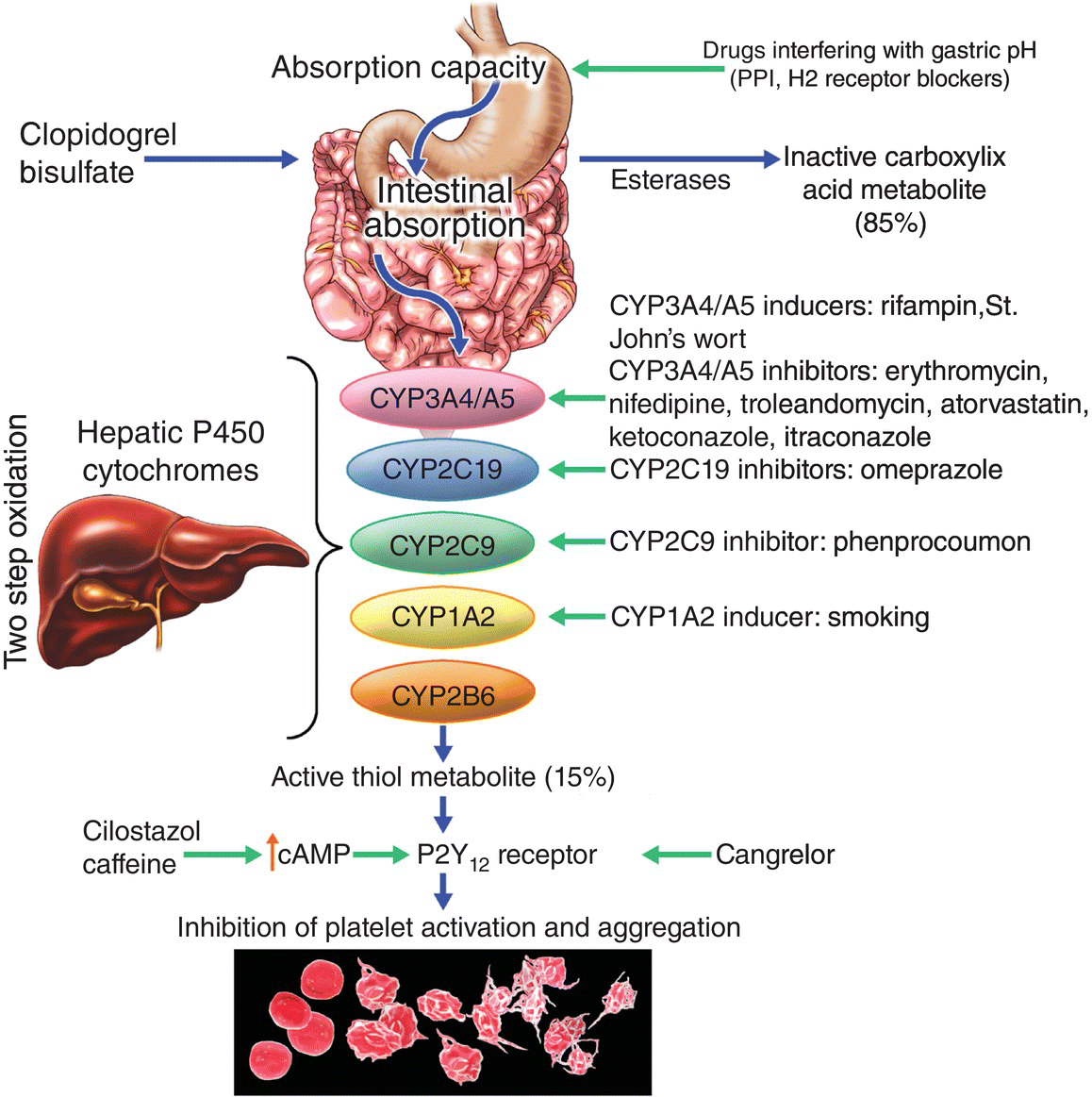37 Eric R. Bates University of Michigan, Ann Arbor, MI, USA Clopidogrel, atorvastatin, omeprazole, and many other drugs require hepatic cytochrome P450 (CYP) metabolism. Because many of these drugs are concomitantly administered to patients with coronary artery disease, the clinical implications of possible pharmacodynamic interactions have raised concern [1]. The proton pump inhibitor interaction with clopidogrel is reviewed in Chapter 36. The purpose of this chapter is to summarize the pharmacodynamic and clinical evidence regarding the other clopidogrel–drug interactions. Clopidogrel bisulfate, an inactive thienopyridine prodrug, is 85% hydrolyzed in vivo by esterases to an inactive carboxylic acid derivative (Figure 37.1). The remaining drug undergoes oxidative biotransformation to its active thiol metabolite by a two-step, CYP-dependent process where CYP3A4/5 and CYP2C19 have the greatest roles, with lesser involvement from CYP2B6, CYP1A2, and CYP2C9. The active metabolite then irreversibly inhibits the platelet P2Y12 adenosine diphosphate (ADP) receptor. This blocks ADP from binding to the receptor and stimulating platelet activation and aggregation. Genetic, cellular, and clinical factors that induce, inhibit, or compete for CYP activity can modulate biotransformation of clopidogrel to its active metabolite and result in interindividual variability of clopidogrel responsiveness. Drug–drug interactions are also important. Figure 37.1 Clopidogrel–drug interactions (Source: Bates ER et al., 2011 [1]. Reproduced with permission of Elsevier.) Atorvastatin was the first drug noted to interact with clopidogrel, establishing that clopidogrel is metabolized by CYP3A4 in humans [2]. However, other pharmacodynamic studies have shown no impact with clopidogrel and atorvastatin coadministration for various reasons, especially when a higher clopidogrel loading dose (600 mg) was tested, when measurements were made several weeks later, or when atorvastatin was added to clopidogrel [1]. Registry, administrative database, and post hoc randomized clinical trial reports have evaluated the potential clinical interaction. Increased risk was seen in two studies [3, 4], but not in three studies [5, 6, 7], two of which used a high clopidogrel loading dose [6, 7]. In other studies, there was an insignificant trend for worse outcomes with atorvastatin compared with pravastatin or no statin [8, 9, 10, 11] and with CYP-metabolized statins compared with non-CYP-metabolized statins [10, 11, 12], but no consistent signal for increased cardiovascular risk with drug coadministration. CYP3A4 inhibitors (erythromycin, troleandomycin, ketoconazole) decrease and CYP3A4 inducers (rifampin) increase the antiplatelet activity of clopidogrel [2, 13]. Several other clopidogrel–drug interactions have also been described (Figure 37.1). Ketoconazole is a potent inhibitor of both CYP3A4 and CYP3A5. Healthy subjects given loading and maintenance doses of clopidogrel had decreased production of active metabolite and significantly reduced platelet inhibition on ketoconazole compared with control [14]. Similarly, the CYP3A inhibitor itraconazole significantly decreased the ability of clopidogrel to inhibit platelet aggregation [15]. Dihydropyridine calcium channel blockers (nifedipine, amlodipine) also inhibit CYP3A4. In ex vivo platelet function studies, they have been shown to decrease clopidogrel responsiveness [16, 17, 18], but no impact on the clinical efficacy of clopidogrel has been demonstrated [19, 20, 21]. Phenprocoumon, an oral anticoagulant used in Europe, is a coumarin derivative metabolized by CYP3A4 and CYP2C9. Concomitant treatment with clopidogrel attenuated the antiplatelet effect of clopidogrel and increased the number of nonresponders [22]. Cangrelor, an ATP analog, is a parenteral reversible P2Y12 receptor inhibitor with a short half-life that results in the normalization of platelet aggregation approximately 30 minutes after discontinuation of the infusion. When clopidogrel was given simultaneously with cangrelor and cangrelor was continued for 2 hours, there was no inhibition of the P2Y12 receptor by clopidogrel after the infusion was stopped because the clopidogrel active metabolite was unavailable for binding due to its short half-life [23]. When clopidogrel was started at the time the cangrelor infusion was discontinued, there was inhibition of the P2Y12 receptor. Clopidogrel responsiveness can be increased by coadministration with rifampin, a CYP3A4 and CYP2C19 inducer, and nonresponders can become responsive [2, 13]. Judge et al. [24] have proven that this response is due to increased production of the clopidogrel active metabolite and increased P2Y12 receptor blockade. By inhibiting the platelet P2Y12 receptor, clopidogrel increases intracellular cyclic adenosine monophosphate (cAMP), a key signaling molecule in inhibiting platelet aggregation. Caffeine also increases cAMP levels and has been shown to enhance platelet inhibition by clopidogrel [25]. Other methylxanthines (theophylline) and phosphodiesterase inhibitors (cilostazol) also increase platelet cAMP levels [26]. Smoking is a known CYP1A2 inducer, and several studies have demonstrated increased platelet inhibition [27, 28], fewer ischemic events [29, 30], and increased bleeding risk [30] in smokers following clopidogrel administration. Other studies have found no impact on clinical events [31, 32]. Omega-3 polyunsaturated fatty acids (PUFA) were shown in one small prospective randomized trial to increase clopidogrel responsiveness, but the mechanism is unclear [33]. St. John’s wort (Hypericum perforatum) is an herbal product used to treat depression. It also induces CYP3A4 activity. In healthy volunteers who were nonresponders to clopidogrel, St. John’s wort 300 mg thrice daily for 14 days improved the platelet inhibitory activity of clopidogrel by increasing CYP3A4 metabolic activity [34].
Other Drug Interactions with Clopidogrel
Introduction
Drug metabolism

The clopidogrel–atorvastatin interaction
Other clopidogrel–drug interactions
CYP inhibitors
CYP inducers
Confounding variables in the drug interaction debate
Stay updated, free articles. Join our Telegram channel

Full access? Get Clinical Tree


